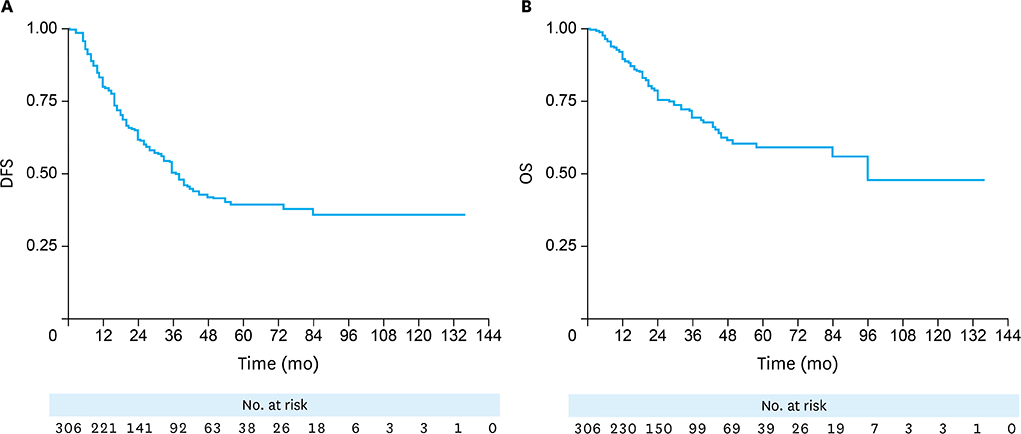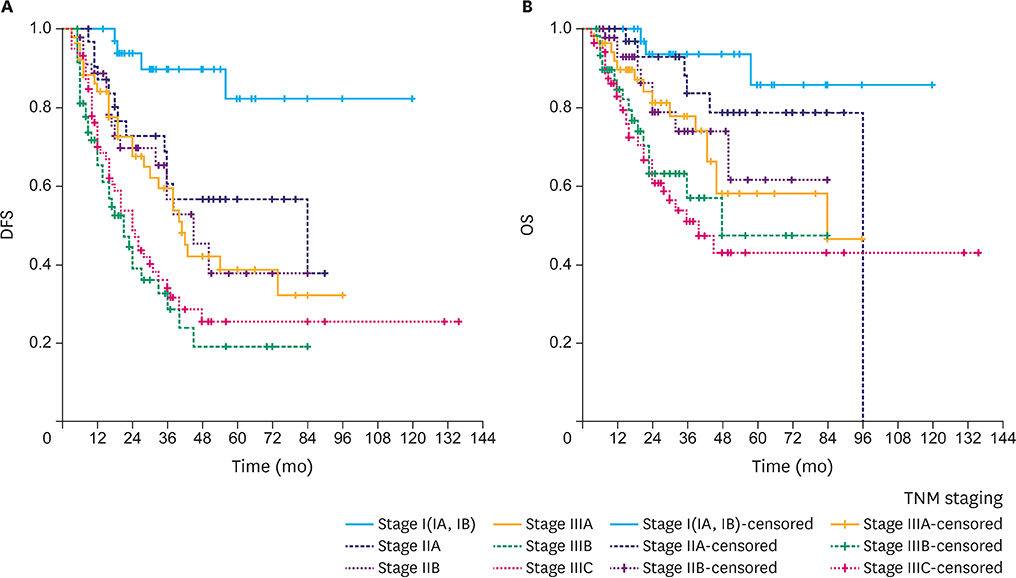J Gastric Cancer.
2017 Mar;17(1):63-73. 10.5230/jgc.2017.17.e7.
Surgical Outcomes Associated with Operable Gastric Cancer in a Tertiary Care Indian Hospital
- Affiliations
-
- 1Upper GI Surgery Unit, Department of General Surgery Unit 3, Christian Medical College, Vellore, India. Joshua_franklyn@yahoo.com
- KMID: 2372583
- DOI: http://doi.org/10.5230/jgc.2017.17.e7
Abstract
- PURPOSE
Data on operable gastric cancer from India is sparse. The purpose of this study was to investigate the clinical details, histopathological demographics, and 5-year overall survival (OS) and disease free survival (DFS) associated with operable, non-metastatic gastric cancer in a dedicated upper gastrointestinal (GI) surgical unit in India.
MATERIALS AND METHODS
Data for patients diagnosed with operable gastric cancer between January 2006 and December 2014 were retrospectively analyzed. Data were collected from electronic hospital records in addition to mail and telephonic interviews when possible.
RESULTS
A total of 427 patients were included. The tumor was located in the pyloro-antral region in 263 patients (61.7%). Subtotal gastrectomy was performed in 291 patients and total gastrectomy in 136 patients. Tumor stage classification revealed 43 patients (10.0%) with stage I, 40 patients (9.4%) with stage IIA, 59 patients (13.9%) with stage IIB, 76 patients (17.8%) with stage IIIA, 96 patients (22.5%) with stage IIIB, and 113 patients (26.4%) with stage IIIC disease. Follow-up data were available for 71.6% of the patients with a mean duration of 32.4 months. Five-year DFS and OS were 39% and 59%, respectively.
CONCLUSIONS
Despite presenting at an advanced stage, the 5-year DFS and OS of patients with operable gastric cancer treated at a dedicated upper GI unit of a tertiary care center in India was good.
Keyword
MeSH Terms
Figure
Reference
-
1. Sankaranarayanan R, Black RJ, Swaminathan R, Parkin DM. An overview of cancer survival in developing countries. IARC Sci Publ. 1998; 135–173.2. Dikshit RP, Mathur G, Mhatre S, Yeole BB. Epidemiological review of gastric cancer in India. Indian J Med Paediatr Oncol. 2011; 32:3–11.3. Allemani C, Weir HK, Carreira H, Harewood R, Spika D, Wang XS, et al. Global surveillance of cancer survival 1995–2009: analysis of individual data for 25,676,887 patients from 279 population-based registries in 67 countries (CONCORD-2). Lancet. 2015; 385:977–1010.4. Sharma A, Radhakrishnan V. Gastric cancer in India. Indian J Med Paediatr Oncol. 2011; 32:12–16.5. Degiuli M, De Manzoni G, Di Leo A, D'Ugo D, Galasso E, Marrelli D, et al. Gastric cancer: current status of lymph node dissection. World J Gastroenterol. 2016; 22:2875–2893.6. Edge SB, Compton CC. The American Joint Committee on Cancer: the 7th edition of the AJCC cancer staging manual and the future of TNM. Ann Surg Oncol. 2010; 17:1471–1474.7. Li X, Liu Y, Cao B, Liu B, Bai T, Li X, et al. Metastatic lymph node ratio and prognosis of gastric cancer at different pT stages. Hepatogastroenterology. 2015; 62:507–511.8. Lee SY, Hwang I, Park YS, Gardner J, Ro JY. Metastatic lymph node ratio in advanced gastric carcinoma: a better prognostic factor than number of metastatic lymph nodes? Int J Oncol. 2010; 36:1461–1467.9. Lee SR, Kim HO, Son BH, Shin JH, Yoo CH. Prognostic significance of the metastatic lymph node ratio in patients with gastric cancer. World J Surg. 2012; 36:1096–1101.10. Zhang CD, Shen MY, Zhang JK, Ning FL, Zhou BS, Dai DQ. Prognostic significance of distal subtotal gastrectomy with standard D2 and extended D2 lymphadenectomy for locally advanced gastric cancer. Sci Rep. 2015; 5:17273.11. Rao DN, Ganesh B. Estimate of cancer incidence in India in 1991. Indian J Cancer. 1998; 35:10–18.12. Shrikhande SV, Sirohi B, Barreto SG, Chacko RT, Parikh PM, Pautu J, et al. Indian Council of Medical Research consensus document for the management of gastric cancer. Indian J Med Paediatr Oncol. 2014; 35:239–243.13. Badgwell B, Blum M, Estrella J, Chiang YJ, Das P, Matamoros A, et al. Predictors of survival in patients with resectable gastric cancer treated with preoperative chemoradiation therapy and gastrectomy. J Am Coll Surg. 2015; 221:83–90.14. American Cancer Society. What are the key statistics about stomach cancer? [Internet]. Atlanta (GA): American Cancer Society;2017. cited 2017 Jan 6. Available from: http://www.cancer.org/cancer/stomachcancer/detailedguide/stomach-cancer-key-statistics.15. Mori M, Sugimachi K, Ohiwa T, Okamura T, Tamura S, Inokuchi K. Early gastric carcinoma in Japanese patients under 30 years of age. Br J Surg. 1985; 72:289–291.16. Wu H, Rusiecki JA, Zhu K, Potter J, Devesa SS. Stomach carcinoma incidence patterns in the United States by histologic type and anatomic site. Cancer Epidemiol Biomarkers Prev. 2009; 18:1945–1952.17. Zheng L, Wu C, Xi P, Zhu M, Zhang L, Chen S, et al. The survival and the long-term trends of patients with gastric cancer in Shanghai, China. BMC Cancer. 2014; 14:300.18. Alberts SR, Cervantes A, van de Velde CJ. Gastric cancer: epidemiology, pathology and treatment. Ann Oncol. 2003; 14:Suppl 2. ii31–ii36.19. Nandi A, Biswas PK, Kar M, Sinha SK. Clinicopathological profile of gastric cancer in a tertiary care hospital in Eastern India: a prospective 2 year study. Clin Cancer Investig J. 2014; 3:14–20.20. Hundahl SA, Phillips JL, Menck HR. The National Cancer Data Base Report on poor survival of U.S. gastric carcinoma patients treated with gastrectomy: fifth Edition American Joint Committee on Cancer staging, proximal disease, and the “different disease” hypothesis. Cancer. 2000; 88:921–932.21. Mickevicius A, Ignatavicius P, Markelis R, Parseliunas A, Butkute D, Kiudelis M, et al. Trends and results in treatment of gastric cancer over last two decades at single East European centre: a cohort study. BMC Surg. 2014; 14:98.22. Swaminathan R, Rama R, Nalini S, Shanta V. Cancer survival in Chennai (Madras), India, 1990–1999. IARC Sci Publ. 2011; 115–124.23. Kim HH, Han SU, Kim MC, Hyung WJ, Kim W, Lee HJ, et al. Long-term results of laparoscopic gastrectomy for gastric cancer: a large-scale case-control and case-matched Korean multicenter study. J Clin Oncol. 2014; 32:627–633.24. Kitano S, Shiraishi N, Uyama I, Sugihara K, Tanigawa N; Japanese Laparoscopic Surgery Study Group. A multicenter study on oncologic outcome of laparoscopic gastrectomy for early cancer in Japan. Ann Surg. 2007; 245:68–72.25. Basu A, Mukherjee N, Roy S, Sengupta S, Banerjee S, Chakraborty M, et al. Ethnic India: a genomic view, with special reference to peopling and structure. Genome Res. 2003; 13:2277–2290.26. Deshpande G, Samarasam I, Chandran BS, Abraham V, George SV, Mathew G. Extended multiorgan resection in locally advanced gastric cancer: a single centre experience from south India. Trop Gastroenterol. 2013; 34:259–263.27. Van Cutsem E, Dicato M, Geva R, Arber N, Bang Y, Benson A, et al. The diagnosis and management of gastric cancer: expert discussion and recommendations from the 12th ESMO/World Congress on Gastrointestinal Cancer, Barcelona, 2010. Ann Oncol. 2011; 22:Suppl 5. v1–v9.
- Full Text Links
- Actions
-
Cited
- CITED
-
- Close
- Share
- Similar articles
-
- Surgical Outcomes of Patients Undergoing Gastrectomy for Gastric Cancer: Does the Age Matter?
- Feasibility of Gastric Cancer Surgery at Low Volume Hospitals
- Robotic Gastrectomy for Gastric Cancer: A Review of Postoperative and Oncologic Outcomes
- Screening of gastric cancer
- Entirely Laparoscopic Gastrectomy and Colectomy for Remnant Gastric Cancer with Gastric Outlet Obstruction and Transverse Colon Invasion



